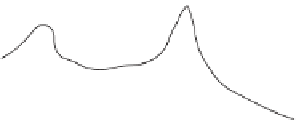Geoscience Reference
In-Depth Information
Figure 13.5
Discontinuities at all
geological scales.
Sandstone
Sediments
Crust
Limestone
Igneous
Pluton
Mantle
Shale
Tectonic
Structural
Lithological
Quartz
Quartz
crystal
flaw
Feldspar
Mica Flakes
Mineralogical
Crystalline
Offshore
Mesozoic,
Cenozoic
Upper
Palaeozoic
Precambrian and Lower Palaeozoic
Mesozoic
Cenozoic
Mesozoic
NW
Snowdonia
Berwyn Hills
Longmynd
Cotswolds
Chilterns
North
Downs
South
Downs
SE
km
Wenlock
Edge
km
1
1
Midland
Plain
London
Basin
English
Channel
Irish
Sea
Weald
0.5
0.5
0
0
Palaeozoic
and Precambrian
basement
-0.5
-0.5
YOUNGEST
Cenozoic
sediments
Cretaceous chalk
and sandstone
Jurassic limestone
& sandstone
Mesozoic
clays, sands
Permo- Triassic
sediments
Carboniferous
sediments
OLDEST
Precambrian
basement
Cambrian
marine sediments
Ordovician volcanics
& marine sediments
Ordovician
plutons
Silurian marine
sediments
Devonian
sediments
Figure 13.6
Geological cross-section from Anglesey to Brighton (450 km), linking structure and relief. Older, resistant igneous
England. Mesozoic sediments in the Irish Sea basin suggest that Wales may have been exhumed from beneath a Mesozoic cover.
during the various processes of rock formation. Pore
water in moderate quantities exerts a 'suction' force,
through surface tension, and its presence depends on rock
porosity.
Normal stress
is the anchoring weight of rock
overlying a point in the mass and depends on rock density
and gravity. Internal
friction strength
is generated at the
contact points of constituent grains and minerals,
determined by their size, shape and packing arrangement
(
texture
). It is additional to cohesion, and is given as an
angle along which shearing would take place; the higher
the angle the greater the strength. Its significance is
seen clearly in a dry scree or pile of loose dry sand, where
the 'angle of rest' equals the friction angle. Mohr-
Coulomb criteria will help us to understand some
principal failure conditions and forms later; meanwhile,
typical component strengths are shown in
Table 13.1
.






















































































































































































































































































































































































































































































































